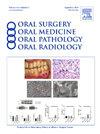Intraosseous schwannoma of the jaws: a case report and systematic review
IF 1.9
3区 医学
Q2 DENTISTRY, ORAL SURGERY & MEDICINE
Oral Surgery Oral Medicine Oral Pathology Oral Radiology
Pub Date : 2025-07-21
DOI:10.1016/j.oooo.2025.04.065
引用次数: 0
Abstract
Introduction
Intraosseous schwannoma (IS), also known as intraosseous neurilemoma, is a benign peripheral nerve sheath tumor postulated to arise de novo or from nerve fibers in pre-existing nutrient canals. ISs are uncommon and comprise less than 1% of neoplasms originating in bone. We herein describe a 66-year-old female who presented with a 4-month history of mandibular pain and pressure. A panoramic radiograph and cone beam computer tomography (CBCT) imaging revealed a well-defined, unilocular radiolucency of the anterior mandible that caused cortical thinning but no evidence of perforation. An incisional biopsy showed a benign spindle cell neoplasm with histologic features of a schwannoma. The tumor cells were strongly reactive for S-100. Complete enucleation was subsequently performed, and the patient is without evidence of disease at 8 months.
Materials and Methods
A systematic review of reported cases was undertaken to evaluate the demographics, clinical features, and treatment of ISs. The review followed the Preferred Reporting Items for Systematic Reviews and Meta-Analyses (PRISMA) guidelines. Eligibility criteria included publications having sufficient clinical and histological information to confirm the diagnosis.
Results and Conclusions
A total of 83 publications and 93 cases were included in the review with the following findings: predominance in females (57%); average age of occurrence of 37.3 years (range of 8-77 years); mean size of 3.6 cm; sites of involvement—mandibular body (37.6%), mandibular body and ramus (18.3%), and anterior mandible (18.3%). The predominant clinical sign was swelling (69.9%), and the majority of patients were asymptomatic (53.8%). The most common radiographic presentation was a radiolucency (94.6%) with well-defined borders (72%). All cases were treated surgically, with the average follow-up interval of 22.9 months. A 5.4% recurrence rate was reported, and recurrence as late as 6 years post-treatment has been documented, suggesting the need for long-term follow-up.
颌骨骨内神经鞘瘤1例报告及系统回顾
骨内神经鞘瘤(IS),也被称为骨内神经鞘瘤,是一种良性周围神经鞘肿瘤,被认为是新生的或来自原有营养管中的神经纤维。ISs并不常见,在骨源性肿瘤中所占比例不到1%。我们在此描述一个66岁的女性谁提出了4个月的历史下颌骨疼痛和压力。全景x线摄影和锥束计算机断层扫描(CBCT)成像显示前下颌骨明确的单眼放射透光,导致皮质变薄,但没有穿孔的证据。切口活检显示为良性梭形细胞肿瘤,具有神经鞘瘤的组织学特征。肿瘤细胞对S-100反应强烈。随后进行了完全摘除术,患者在8个月时无疾病迹象。材料和方法对报告病例进行系统回顾,以评估ISs的人口统计学、临床特征和治疗。该评价遵循了系统评价和荟萃分析的首选报告项目(PRISMA)指南。入选标准包括有足够临床和组织学信息来证实诊断的出版物。结果与结论共纳入83篇文献和93例病例,结果如下:女性居多(57%);平均发病年龄37.3岁(范围8 ~ 77岁);平均尺寸3.6 cm;受累部位:下颌骨体(37.6%)、下颌骨体及支(18.3%)、前颌骨(18.3%)。临床体征以肿胀为主(69.9%),无症状者占53.8%。最常见的x线表现是放射透光度(94.6%),边界清晰(72%)。所有病例均行手术治疗,平均随访时间22.9个月。复发率为5.4%,治疗后6年仍有复发记录,提示需要长期随访。
本文章由计算机程序翻译,如有差异,请以英文原文为准。
求助全文
约1分钟内获得全文
求助全文
来源期刊

Oral Surgery Oral Medicine Oral Pathology Oral Radiology
DENTISTRY, ORAL SURGERY & MEDICINE-
CiteScore
3.80
自引率
6.90%
发文量
1217
审稿时长
2-4 weeks
期刊介绍:
Oral Surgery, Oral Medicine, Oral Pathology and Oral Radiology is required reading for anyone in the fields of oral surgery, oral medicine, oral pathology, oral radiology or advanced general practice dentistry. It is the only major dental journal that provides a practical and complete overview of the medical and surgical techniques of dental practice in four areas. Topics covered include such current issues as dental implants, treatment of HIV-infected patients, and evaluation and treatment of TMJ disorders. The official publication for nine societies, the Journal is recommended for initial purchase in the Brandon Hill study, Selected List of Books and Journals for the Small Medical Library.
 求助内容:
求助内容: 应助结果提醒方式:
应助结果提醒方式:


